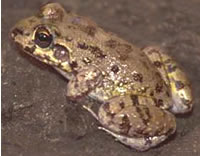
Dimdima
Online Children's Magazine from India

Dimdima
Online Children's Magazine from India



By Rani Iyer

Poa had spent her summer studying frogs in Argentina. One day she told me the unbelievable tale of mud frogs. She worked at night watching the frogs in the pond, counting them as they emerged from their hiding place. “These frogs build burrows and survive in extremely arid conditions,” she said.
I was not sure if she was serious. Frogs, as we all know, need water. They can live in wells, ponds, pools, streams or rivers. So what was she talking about? My search led me to Leptodactylus bufonius, the mud frog. Until relatively recently very little was known about this species. It was thought to lay its eggs inside the burrows of Vizcacheras, a South American rodent.
It is now known that the males construct the mud nests, within about 90 minutes, and that the female of a mating pair seals the small entrance hole of the nest with a mud cap once the eggs have been laid. The females deposit about 500 eggs within gelatinous white foam in each nest. The tadpoles hatch and develop inside the nest. The tadpoles are then dependent on rainfall to flood the nest, soften the cap and allow them to escape into the surrounding water. The females lay all their eggs in one nest, and each nest only has the eggs from one female. Tadpole mortality within nests appears to be absent.
The story of this fascinating frog in a harsh climate where daytime and nighttime temperatures exceeds 500C and 300C is a lesson in survival. Such adaptations are one reason that life thrives and survives in unexpected places.
But the discovery of the mud frog also stirred up my memory. As children we have heard stories where rocks or stones were said to contain a little water housing a frog. Do such frogs exist? Has anyone looked for it? Now this is a lead for another fascinating story. Any takers?
Last updated on :3/26/2004
EXPLORE MORE...
COMMENT ON THIS ARTICLE
Wants to share something related to this article? Please use the form below.
Dimdima is the Sanskrit word for ‘drumbeat’. In olden days, victory in battle was heralded by the beat of drums or any important news to be conveyed to the people used to be accompanied with drumbeats.
Bharatiya Vidya Bhavan
K. M Munshi Marg,
Chowpatty, Mumbai - 400 007
email : editor@dimdima.com
Bharatiya Vidya Bhavan
505, Sane Guruji Marg,
Tardeo, Mumbai - 400 034
email : promo@dimdima.com
Dimdima.com, the Children's Website of Bharatiya Vidya Bhavan launched in 2000 and came out with a Printed version of Dimdima Magazine in 2004. At present the Printed Version have more than 35,000 subscribers from India and Abroad.